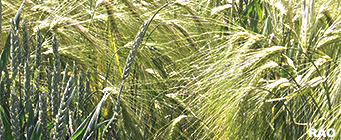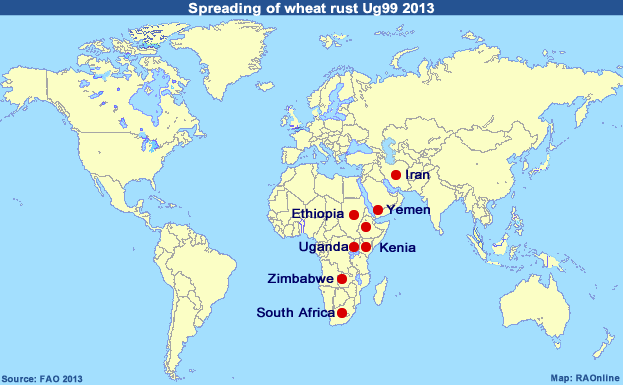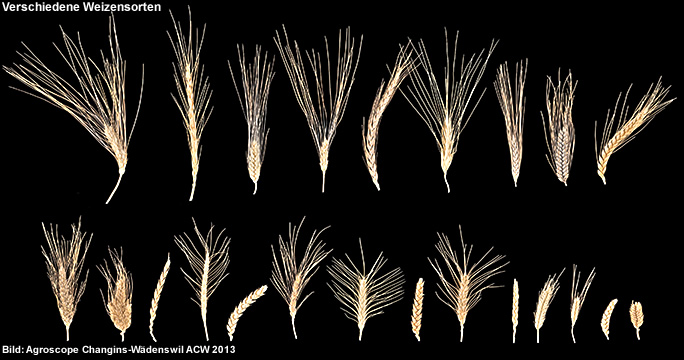| Economy |
| Agriculture |
|
 |
| Thema: Wirtschaft, Handel & Beruf |
| Cereals |
| Wheat rust |
Wheat rusts are a major threat to food security
A multinational effort supported by the International Atomic Energy Agency and FAO marked a key milestone this week when a Kenyan university debuted two new varieties of disease-resistant wheat to the nation's farmers.
Over the past two days, thousands of Kenyan farmers have visited Eldoret University in western Kenya for a two-day agriculture fair highlighting the latest farming technologies.
Supporting the development of the new varieties were the IAEA's Technical Cooperation Department and the Joint FAO/IAEA Programme of Nuclear Techniques in Food and Agriculture.
They manage an interregional technical cooperation project to develop varieties of wheat that are resistant to a devastating type of fungus, causing a disease known as wheat stem rust.
Wheat stem rust was under control for over 30 years, but a resurgence of the disease was discovered in 1999 in Uganda that swiftly spread to neighbouring Kenya.
Ug 99
The wheat stem rust, caused by the strain of the fungus known as Ug99 named after its place and year of origin, has since spread to Iran, Yemen and South Africa and threatens crops as far away as India as spores are carried by wind. Parasitic rusts threaten global wheat production, reducing plant growth and crop yields. The disease can destroy up to 70-100 percent of the yield of wheat crop if not prevented.
"Improving food security in developing countries through the use of nuclear techniques is an important priority of the IAEA," said IAEA Director-General Yukiya Amano. "I am pleased that we have been able to make an important contribution to fighting wheat stem rust."
"Wheat rusts, particularly the Ug99 strain, are a major threat to food security because rust epidemics can result in devastating yield losses. This international project involving affected countries, plant scientists and breeders and international organizations is a major breakthrough. It clearly shows the benefits of FAO/IAEA collaboration and that working together we can overcome the challenges we face," said FAO Director-General Jose Graziano da Silva.
The rust-resistant wheat varieties were developed with the support of an IAEA technical cooperation project, Responding to the Transboundary Threat of Wheat Black Stem Rust (Ug99), which involved more than 20 nations and international organizations.
The varieties were developed using a nuclear technique for crop improvement known as mutation breeding. By exposing seeds, or plant tissue, to radiation, scientists accelerate the natural process of mutation, and then breeders are able to select and develop new varieties.
In 2009, Miriam Kinyua, a Kenyan plant breeder, sent 10 kilograms of five varieties of wheat seed to the FAO/IAEA laboratories in Seibersdorf, south of Vienna, where they were irradiated for mutation breeding.
These seeds were returned to Kenya where they were planted in a hot spot for the disease for screening and selection. Kinyua and her colleagues at the University of Eldoret's Biotechnology Department identified eight lines resistant to Ug99. Four of these lines were submitted to Kenyan national performance trials, and two were officially approved as varieties by the national committee of the Ministry of Agriculture.
About six tonnes of seeds of the new varieties will be made available this month for the next planting season in Kenya.
| Source: FAO, September 2013 |
 |
| Wheat rust tracking site launched |
FAO launches Rust SPORE to step up global surveillance of Ug99 strain
FAO has launched a new website to track the advance of Ug99 the devastating strain of wheat stem rust disease and other wheat rusts amid concern the fungus is on the march across Africa and could head toward South Asia.
The aim of "Rust SPORE" is to deliver up-to-date information on the status of wheat stem rust, monitor important new strains of the disease and synthesize and provide easy access to reliable data on a global scale.
The information is retrieved from field data provided by national surveillance teams in cooperating countries that have been trained in using harmonized surveillance protocols and forming an international rust surveillance network.
The recent report of the spread of a virulent Ug99 variant into South Africa has raised further concern about the spread of this disease, which presents a severe threat to the world's wheat crops. There are currently seven recognised variants of the strain to which 90 percent of global commercial wheat varieties are vulnerable.
Centuries old problem
Throughout recorded history fungal rust diseases have been a recurring threat to wheat crops worldwide. Three rust diseases - stem (black), stripe (yellow) and leaf (brown) rust - are the most economically damaging diseases affecting wheat production. However, recently there has been an escalation in the threat posed by both stem and stripe rust.
"Emergence of the Ug99 races in East Africa transformed stem rust from a disease largely under control into a significant global threat," said David Hodson, FAO's international focal point for wheat rust disease.
"Ug99 is like the flu virus, it evolves continuously. The continued spread of Ug99, and the appearance of new variants that have broken down even more key resistance genes is increasing the danger it poses.
Carried on clothes
Wheat rust moves by the wind but can also be carried on clothes or in plant matter and the worry is it can jump continents by an unwitting human carrier.
Rust SPORE is part of FAO's Wheat Rust Disease Global Programme and an important part of the BGRI efforts to mitigate the effects of wheat rust diseases globally.
First discovered in Uganda in 1999, the original pathogen of Ug99 has been confirmed in Ethiopia, Kenya, Sudan and Iran; variants of the disease have now been recorded in Kenya, Ethiopia, South Africa and Zimbabwe.
The main aims of coordinated international efforts are surveying and monitoring pathogen changes, developing new resistant varieties, supporting countries in their preparedness and the quick seed multiplication of resistant varieties and support to farmers for changing varieties.
Agressive yellow strains
Another global concern is the recent detection of new very aggressive strains of yellow or stripe rust that are crossing continents and getting established at an extremely rapid rate, causing serious outbreaks in many countries.
These new stripe rust strains pose an additional threat to wheat production since they are adapted to warmer temperatures, previously limiting the occurrence of yellow rust in cooler areas.
"This year millions of dollars in crop losses are likely because of yellow rust outbreaks in the Middle East, Central Asia, Caucus and North Africa," said Hodson.
Rust SPORE information system is presently focusing on stem rust and Ug99, but will be expanded to incorporate other wheat rust threats in the near future.
| Source: FAO, June 2013 |
 |
| Links |
| Externe Links |
|
|
 |